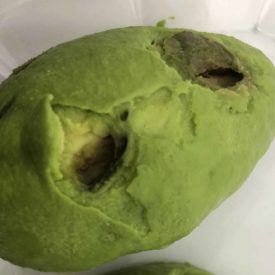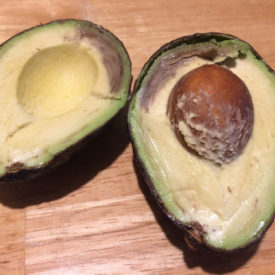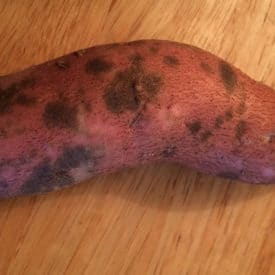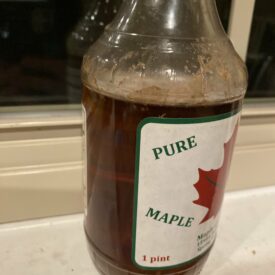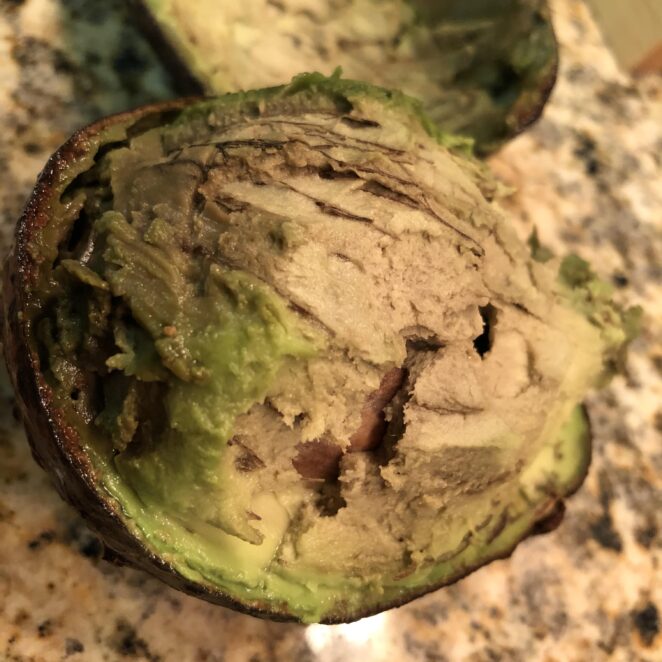
Avocados can “go bad” in many different ways. You’ll know an avocado is rotten if you cut into it and discover widespread discoloration in shades of brown, gray and black, as well as damaged flesh. You may see round lesions where microbes have been digging in or darkened areas where the flesh has been dented and bruised and/or eaten away. You may also see shiny, translucent gelatinous spots, evidence of microbial growth. The avocado might be brown, black or slimy just under the peel. Its texture may be oddly soft or mushy and you may also notice an odor. All this can vary depending on what exactly caused the avocado’s demise.
In some cases, you may be able to see how the avocado was damaged. For example, if the avocado is most ruined near the stem, that’s a clue that a microbe entered through an opening there. If the avocado looks gray and unappealing throughout, it might have been harmed by too cold temperatures. Depending on how far that graying has advanced, the avocado might still be OK, or you may be able to eat around any problem areas.

Can you eat a rotten avocado?
A thoroughly rotted avocado? We don’t recommend it.
If, however, you cut into an avocado and see only limited browning (maybe streaks or dots, like in this post) or only a corner that’s turned black, or just some black thumb-print-shaped spots, then the avocado might still be OK. In cases like those, it may not be rotten at all. Just try some of it. If it tastes fine, then it’s most likely fine to eat. You’ll probably just want to trim off any black areas.
Check out EatOrToss’s Avocado Library for more examples of funky-looking avocados, some of which are totally fine.
Can you tell, from the outside, if an avocado is rotten?
You can’t always tell from looking at the outside that an avocado is rotten. But sometimes there are clues. As the avocado loses moisture and mass, the skin may wrinkle and sink—this wrinkly skin can appear more often in avocados that are rotting. But if the avocado on your counter has some patches of crinkly skin, especially around the neck, don’t give up until you slice into it and confirm that it really is rotten. The wrinkly areas could be be caused by nothing more than water loss.
A rotten avocado may also develop an odor.
Can an avocado get moldy?
While avocados often succumb to fungi I rarely see fuzzy or fluffy molds on the fruit, even in my high-avocado-consumption household. But it is possible. Sometimes, mold can develop on the outside, like this. This is a “toss” (compost!).
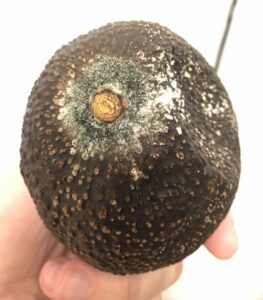
In extreme cases, you can also see mold on the inside of an avocado, like the white fluff just under the peel in this avocado:
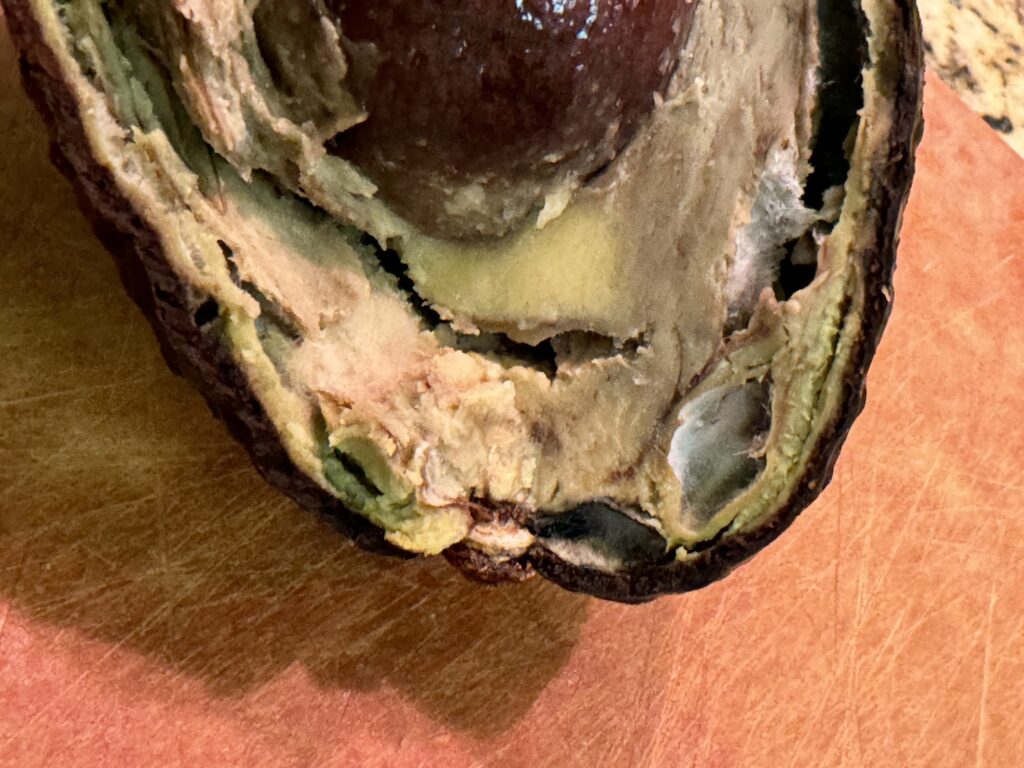
The avocado above has what scientists describe as “stem end rot.” A fungus entered the avocado through the stem, spread through the rest of the fruit and did its dirty work. You know things were going swimmingly for the fungus because it started growing a cottony mycelium, or fungal body, in a cavity at the top of the avocado.
What causes avocados to rot?
Avocados rot for a number of reasons, including:
- Natural, pre-programmed cell death (not to be dramatic about it, or anything). From the avocado tree’s perspective, the green flesh of the fruit was always supposed to be temporary, only a vehicle designed to eventually disappear so the seed has a chance at becoming a new avocado tree. It’s also not physically possible for an avocado, which is a living, breathing entity, to keep functioning forever. While still on the tree, roots and leaves send it energy and nutrients. But after it’s picked, the avocado will gradually deplete its reserves and then fall apart. Ultimately this means its cells break down. Those cells leak various chemicals, which lead to chemical reactions that turn the avocado’s flesh into shades of brown, black and gray. Everything gets mushier.
- Microbial attack. Microbes, particularly certain fungi, enjoy avocados as much as we do. As the avocado ripens and softens, it gets easier for them to slip into the avocado and eat its flesh. To eat the avocado they excrete enzymes that break it down, which can change the look, texture, smell and taste of the fruit. Various fungi leave different sets of signatures. As with natural aging, once cells are damaged, the avocado discolors.
- Too cold temperatures. Avocados aren’t built for cold temperatures and their ripening process goes haywire if they’re kept too cold. Putting an unripe avocado in the fridge can cause it to discolor. An avocado refrigerated while it’s immature and unripe might never properly ripen; it might turn gray and brown on the inside, and its inner channels could turn brown. You’ll see the browning of those vascular bundles as brown lines or dots, depending on how you slice the fruit.
- Injuries. A bump or scrape alone won’t rot an avocado, but can damage cells enough that they turn black. In addition to leading to an unsightly bruise, the damage can make it easier for microbes to get in and do their dirty work.
- Poor storage and handling. If the folks handling your avocados before they get to the store don’t do things right, they set the avocado up for problems either immediately or later, even as late as when it’s sitting on the counter in your kitchen. If avocados are too cold or too warm during their supply chain journey, problems, like discoloration and stalled ripening, can accelerate. Even at a good temperature, storing them for too long can cause funky things to happen. And, of course, rough handling anywhere between the farm and your home will make avocados more likely to get bruises that can lead to brown and black spots and microbial infections.
Is it safe to eat a rotten avocado?
The most likely outcome from eating a rotten avocado is that it will taste bad. If an avocado rots simply because of physical factors, like cold temperatures or aging, it may not even be hosting any advanced microbial growth. If it’s succumbing to microbes, well, we don’t advise eating food with evidence of uninvited microscopic critters feasting on it, but to the best of my knowledge and research it is rare for the organisms known to attack avocados to impact human health. This is logical as these fungi are pros at eating avocados, not messing with mammals like us!
Avocado rots also tend to take place within the fruit and don’t usually feature any oozing or leaking of liquid—such circumstances would make it easier for bacteria, possibly bacteria that could sicken a person, to grow. But, as on any raw fruit or vegetable, bacteria, including human pathogens, can be lurking on an avocado and waiting for the right opportunity, perhaps one created by rot inside the fruit. (And while we’re here, please don’t follow a certain social media trend and try to extend the life of your whole avocados by submerging them in water for weeks on end. Even in the fridge, this provides an opportunity for bacteria, specifically Listeria monocytogenes, to grow!)
So, while a thoroughly rotten avocado isn’t as risky as, say, raw chicken, we don’t recommend you eat one. If only a small area is suffering, you’re probably fine to cut it off (and if you’re immunocompromised you may want to be more conservative).
Check out our Avocado Library to see examples of avocados with various issues.
How can you prevent avocados from rotting?
While you can’t keep an avocado good forever, there are things you can do to extend its shelf life.
First, handle them gently at the store. My habit is to buy hard avocados and let them soften on the counter. If you want to slow their ripening, keep them away from other fruit, especially bananas, which emit a gas that accelerates ripening. (And if you’re in a hurry, put them in a breathable bag with other fruit and they’ll soften faster.)
You’ll know they’re ripe when they give a little when squeezed (but don’t press too hard!). At that point if you aren’t yet ready to use them, put them in the fridge. While the fridge will prevent an unripe avocado from properly ripening, once an avocado IS ripe, the cold temperature will slow the aging process and keep it in the guacamole zone for longer.
Visit EatOrToss’s Avocado Library for images of avocados with various issues.
SOURCES:
- The International Avocado Quality Manual. Edited by Anne White and Alan Woolf (Plant & Food Research, New Zealand); Peter Hofman (Primary Industries and Fisheries, Department of Employment, Economic Development and Innovation, Queensland, Australia); Mary Lu Arpaia (University of California, Riverside).
- This is what happens when you press your avocado too hard. R. Jackson. EatOrToss. July 2022.
- Brown area inside avocado. R. Jackson. EatOrToss. June 2020.
- Brown dots or streaks in your avocado? R. Jackson. EatOrToss. May 2020.
- FDA Warns Popular Avocado Hack Could Be Breeding Salmonella. Kate Fowler. Newsweek. May 20, 2022.
- Microbiological Surveillance Sampling: FY14-16 Whole Fresh Avocados. U.S. Food and Drug Administration. Content current as of 2/25/2022.

